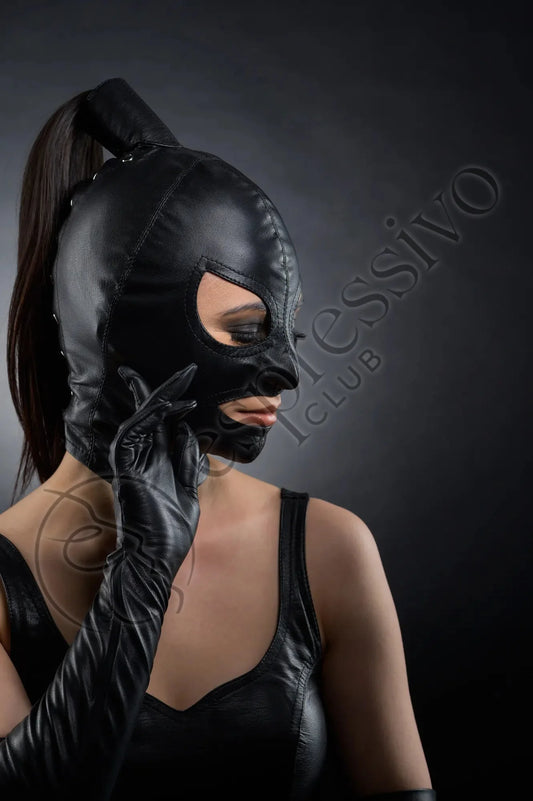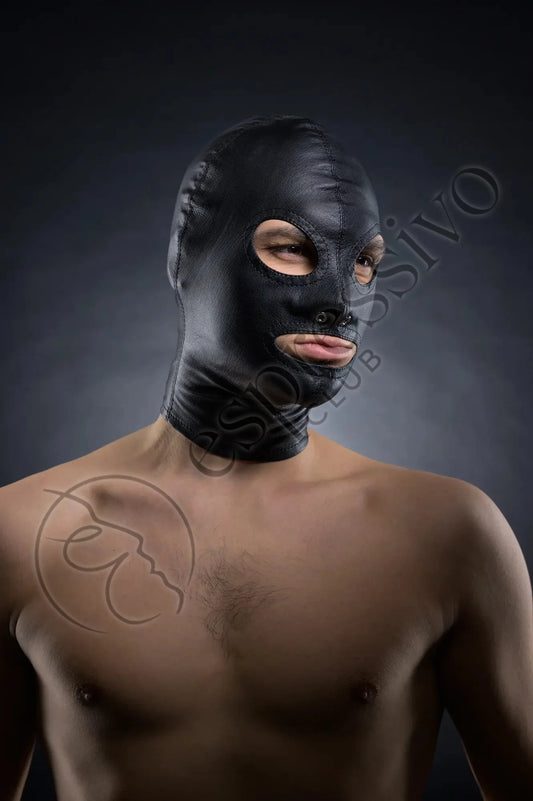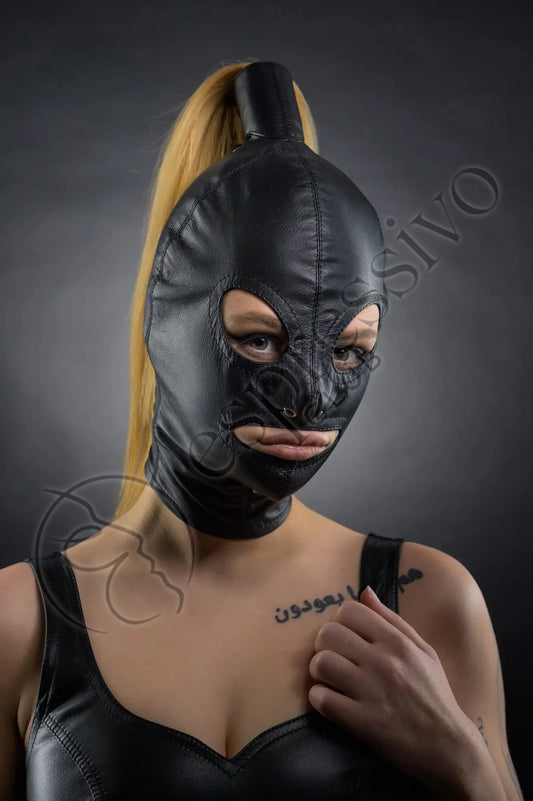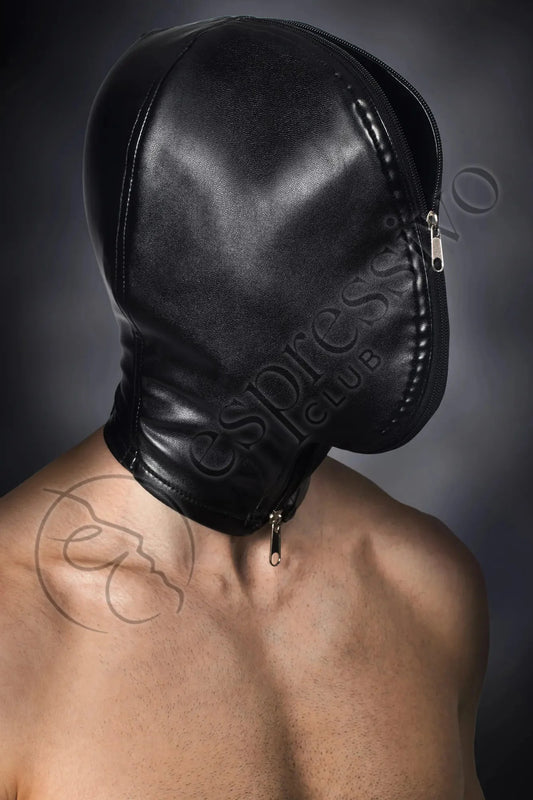Bondage hood
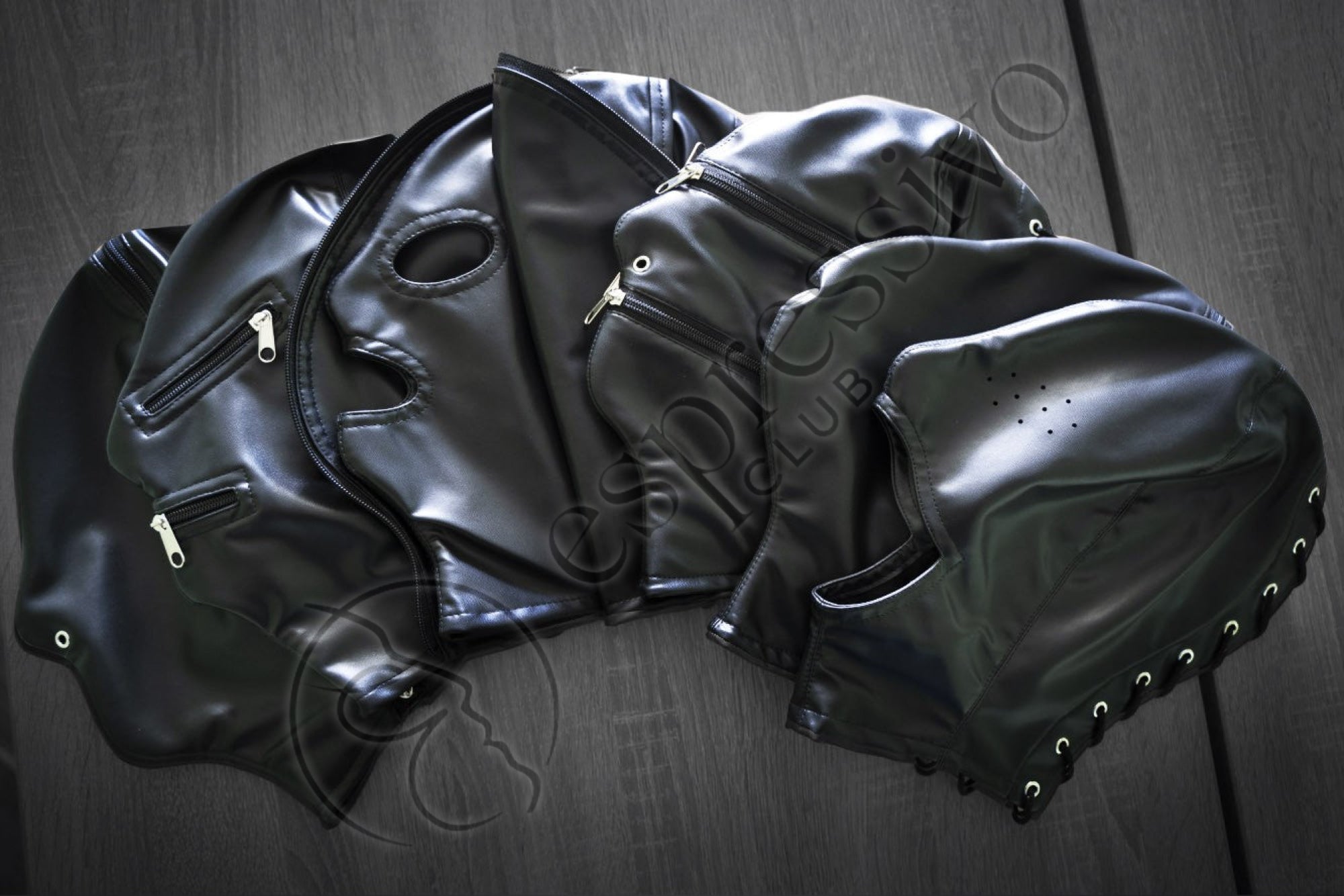
(A selection of leather bondage hoods in various styles, designed and crafted in our fetish studio. Explore our Collection of bondage hoods and BDSM masks to learn more about their features.)
A bondage hood, also known as a bondage mask, is the collective name of various models and modifications of BDSM hoods that completely cover the head and restrict vision, hearing, touch, breathing and access to the mouth. They can be made of any fetishistic materials such as leather, latex (rubber), PVC, but due to the specifics of this product, they are most often made of leather - real or faux. Recently, the widely used material for hoods, mainly due to the low production cost, is lycra (spandex). Such hoods, although advertised as bondage hoods, are difficult to define as such due to the low insulating properties of spandex and its high stretchiness, which put it very far from the minimum requirements that a bondage hood should cover. In most cases, spandex hoods are a rough visual copy of originals made of leather (see fake mask).
There is a wide variety of bondage hoods. In general, they can be divided into hoods for maximum restraint (hoods with breathing openings only) or those with moderate restraint (e.g. hoods with perforated eyes and/or mouth opening). There are also models that allow control and/or adjustment of the degree of restraint by closing mechanisms such as zippers at the front of the hood (see zipper mask) or attaching additional accessories such as bondage blindfold and mouth gag.
The bondage hoods can follow the shape of the head (see tight bondage hoods), have more or less the shape of a balloon (see breathplay hoods) or have the shape of a bag (see bondage baghood). Depending on their purpose, they can be bondage hoods that limit vision, hearing and speech (sensory deprivation hoods), breath control hoods and suffocation masks, interrogation hoods, etc. Such a division is in many cases conditional, as rarely one mask has a single function. In most cases, the restriction affects more or less all the important aspects such as sight, hearing, touch, breathing, speech, etc., and the only difference is the degree of covering each of them.
Bondage hoods are considered heavy bondage gear and are usually designed for short-term wear (e.g. during bondage session, interrogation play or obedience training), but there are also models that provide more comfort and more security allowing longer wear (within a few hours). The idea of wearing a bondage hood 24/7 in general is just a fantasy, the practical implementation of which significantly increases the traditional risks associated with their use (see below).
The idea of Bondage hood to achieve maximum isolation and sensory deprivation can make their use extremely risky, especially if you approach them recklessly. The most common and immediate danger is suffocation (especially with breathplay hoods). There are other risks that are often underestimated, such as spatial disorientation leading to collisions with objects, tripping, falls and the resulting physical trauma, psychological breakdowns and panic attacks (especially with prolonged wear combined with intense play, e.g. in interrogation play) and, in limited cases, to mental disorders.
The most common safety tips when using bondage hoods are:
• not to obstruct or block the air holes,
• not to use additional tools for breathing restriction,
• not to play alone, resp. not to leave the partner unattended (although many bondage lovers use bondage hoods just when playing alone)
• and especially the choice of head gear should not be left to chance, but to be as thoughtful and consistent with experience and individual capabilities.
A good solution when choosing a bondage hood is to prefer such models that have mechanisms for quick release in an emergency situation. The existence or non-existence of such mechanisms does not eliminate personal responsibility.
For more details, see bondage.
There is a wide variety of bondage hoods. In general, they can be divided into hoods for maximum restraint (hoods with breathing openings only) or those with moderate restraint (e.g. hoods with perforated eyes and/or mouth opening). There are also models that allow control and/or adjustment of the degree of restraint by closing mechanisms such as zippers at the front of the hood (see zipper mask) or attaching additional accessories such as bondage blindfold and mouth gag.
The bondage hoods can follow the shape of the head (see tight bondage hoods), have more or less the shape of a balloon (see breathplay hoods) or have the shape of a bag (see bondage baghood). Depending on their purpose, they can be bondage hoods that limit vision, hearing and speech (sensory deprivation hoods), breath control hoods and suffocation masks, interrogation hoods, etc. Such a division is in many cases conditional, as rarely one mask has a single function. In most cases, the restriction affects more or less all the important aspects such as sight, hearing, touch, breathing, speech, etc., and the only difference is the degree of covering each of them.
Bondage hoods are considered heavy bondage gear and are usually designed for short-term wear (e.g. during bondage session, interrogation play or obedience training), but there are also models that provide more comfort and more security allowing longer wear (within a few hours). The idea of wearing a bondage hood 24/7 in general is just a fantasy, the practical implementation of which significantly increases the traditional risks associated with their use (see below).
The idea of Bondage hood to achieve maximum isolation and sensory deprivation can make their use extremely risky, especially if you approach them recklessly. The most common and immediate danger is suffocation (especially with breathplay hoods). There are other risks that are often underestimated, such as spatial disorientation leading to collisions with objects, tripping, falls and the resulting physical trauma, psychological breakdowns and panic attacks (especially with prolonged wear combined with intense play, e.g. in interrogation play) and, in limited cases, to mental disorders.
The most common safety tips when using bondage hoods are:
• not to obstruct or block the air holes,
• not to use additional tools for breathing restriction,
• not to play alone, resp. not to leave the partner unattended (although many bondage lovers use bondage hoods just when playing alone)
• and especially the choice of head gear should not be left to chance, but to be as thoughtful and consistent with experience and individual capabilities.
A good solution when choosing a bondage hood is to prefer such models that have mechanisms for quick release in an emergency situation. The existence or non-existence of such mechanisms does not eliminate personal responsibility.
For more details, see bondage.

